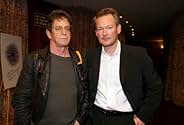The woman who is critical of Wagstaff & Mapplethorpe's relationship is Eugenia Parry (who has written or edited a number of books on photography, most recently on Joel Peter Witkin). She is shown and identified speaking about Wagstaff's intellectual pedigree, and is shown briefly -- but not identified again -- before the first negative statement, which is a voice- over images of a young Mapplethorpe. Then later she has another voice over with other images, followed by another comment about Mapplethorpe's manipulativeness (from, I think, Holly Solomon).
Identifying speakers always seems to be a problem with documentaries. There's a balance to be struck between assuming the audience isn't paying attention and must be told each and every time a speaker appears, and assuming the audience can keep track of dozens of separate speakers with only a single identification. Obviously if you're making a film with only two or three speakers, you can cut back on identifiers (especially if those speakers also have distinctive voices or speech mannerisms). But sometimes minimalism can be carried too far, and my feeling is that the more speakers you have, the more you need to be careful about identifying them.
As an additional note, the closed-captions for this film generally don't identify speakers, either, except for the narrator (who is never visible in the film, and whose voice sometimes picks up from another speaker during montages of images).












